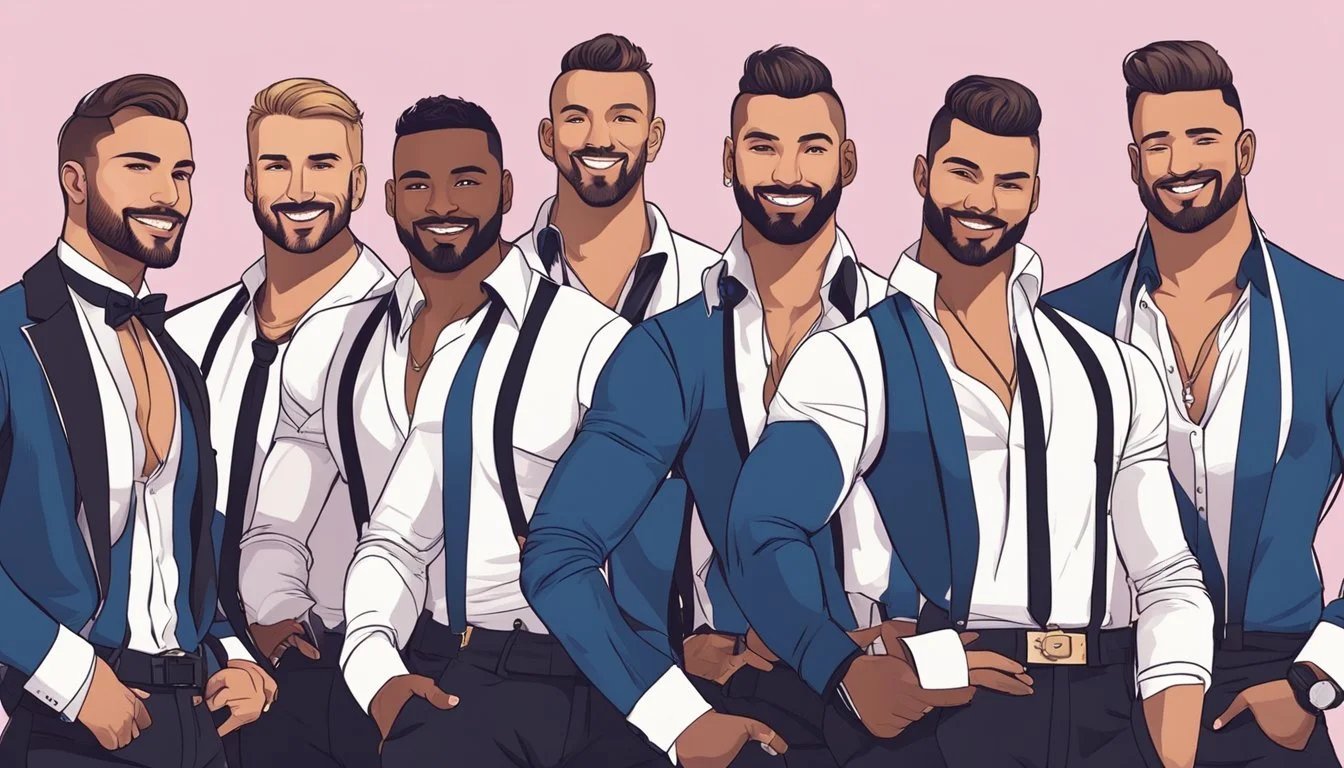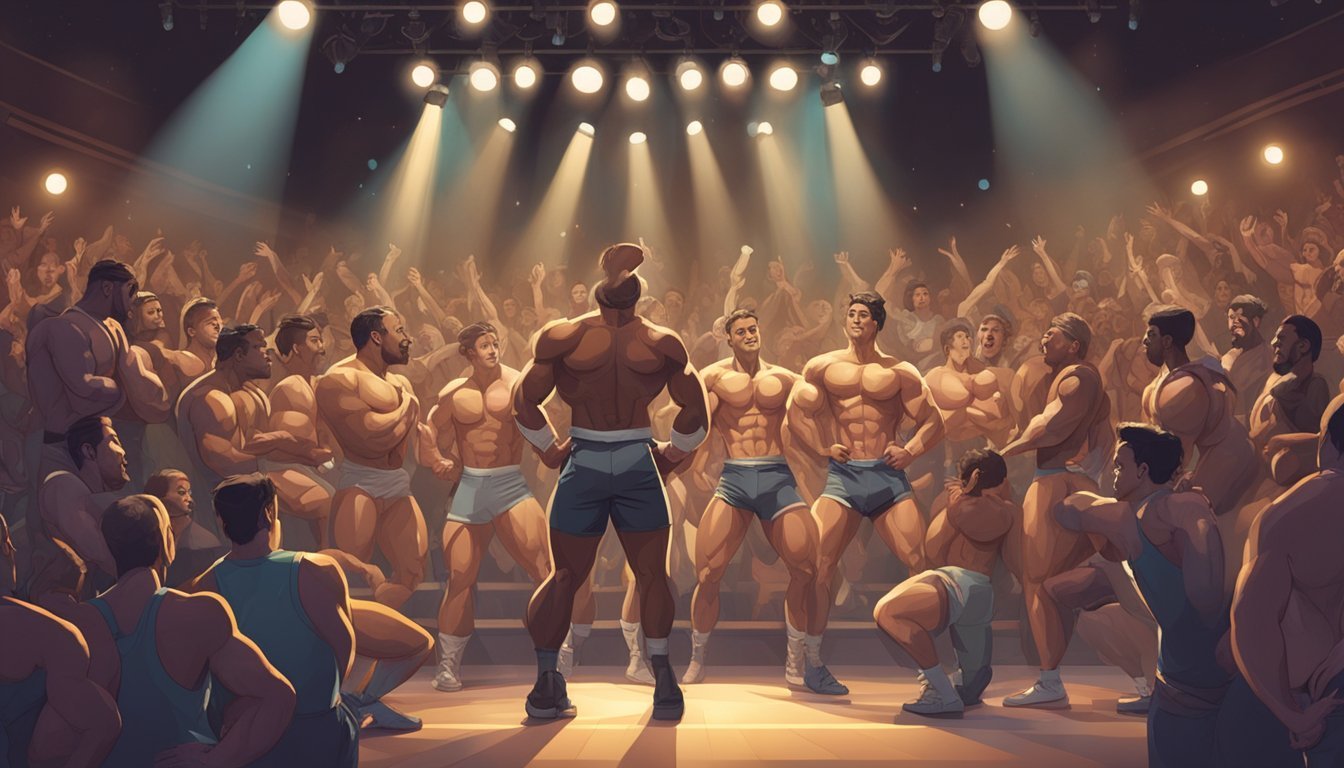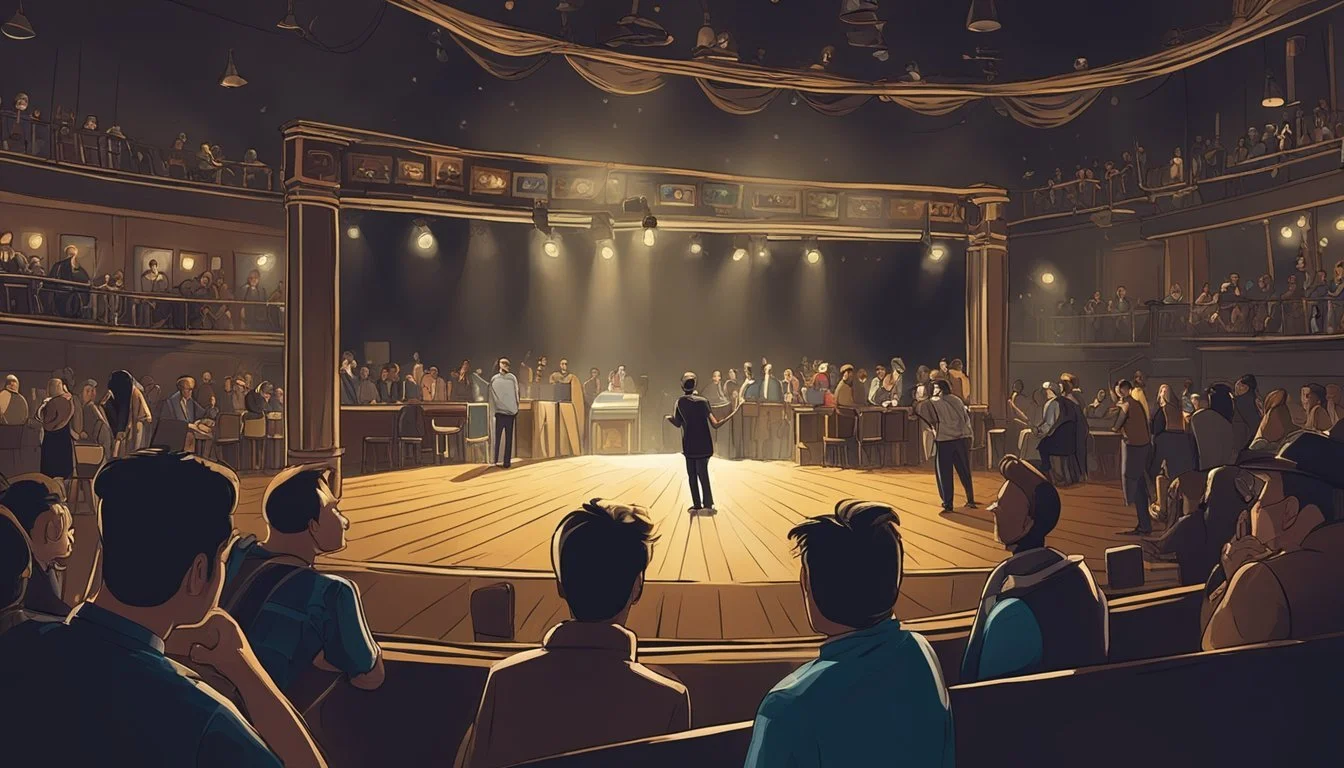Welcome to Your Fantasy: Chippendales Podcast Strips Down for the Camera
Behind-the-Scenes Look at Male Revue
Welcome to Your Fantasy, a new podcast series, uncovers the scandalous history behind the Chippendales male dance revue. The show exposes a dark underbelly of greed, corruption, and even murder lurking beneath the oiled pecs and non-stop parties. Historian Natalia Petrzela takes listeners on a journey through the rise and fall of this cultural phenomenon that captivated audiences in the 1980s.
The podcast delves into the complex story of Chippendales owner Steve Banerjee and the empire he built. From humble beginnings to international stardom, the male dancers became symbols of women's liberation and sexual empowerment. Yet behind the scenes, a web of scandals and legal troubles threatened to bring down the entire organization.
Welcome to Your Fantasy offers a compelling mix of true crime and cultural history. The series explores racial discrimination lawsuits, backstage drama, and the tragic events that ultimately led to Banerjee's downfall. Through interviews and archival material, it paints a vivid picture of an era and an entertainment brand that left an indelible mark on popular culture.
The Origins of Chippendales
Chippendales began as a modest nightclub in Los Angeles before evolving into a cultural phenomenon that swept across America in the 1980s. The brand's success stemmed from the entrepreneurial vision of an Indian immigrant who tapped into changing social dynamics.
Steve Banerjee: The Indian Immigrant Behind the Brand
Steve Banerjee arrived in the United States with dreams of business success. After a series of failed ventures, he purchased a struggling Los Angeles nightclub in 1975. Banerjee's innovative idea to introduce male exotic dancers targeting female audiences proved transformative.
Initially featuring amateur performers, Chippendales quickly gained popularity. Banerjee refined the concept, implementing strict fitness standards and the iconic "cuffs and collars" uniform. His business acumen and willingness to push boundaries helped Chippendales stand out in the competitive nightlife scene.
Chippendales: From Nightclub to Cultural Phenomenon
Chippendales rode the wave of women's liberation in the 1980s. The shows offered a space for female audiences to openly express their sexuality. This concept was revolutionary at the time.
The brand expanded rapidly, opening venues in New York and abroad. Chippendales became synonymous with girls' nights out and bachelorette parties. Their calendar sales soared, and touring shows packed venues across the country.
Media coverage further propelled Chippendales into the mainstream. The muscular dancers became pop culture icons, appearing on talk shows and in films. This visibility cemented Chippendales' place in 1980s American culture.
Rise to Mainstream Fame
Chippendales catapulted into the public eye in the 1980s, becoming a cultural sensation. The male dance troupe captivated audiences with their provocative performances and iconic costumes.
Breaking into Daytime TV and Beefcake Calendars
Chippendales made their daytime television debut on Phil Donahue's show in 1979. This exposure introduced them to a wider audience, particularly women who were intrigued by the concept of male exotic dancers.
The troupe's popularity soared, leading to appearances on other talk shows and variety programs. Their muscular physiques and choreographed routines became a hot topic of discussion.
Capitalizing on their growing fame, Chippendales released beefcake calendars featuring their most popular dancers. These calendars flew off the shelves, adorning walls in homes and offices across the country.
G-Strings and Bow Ties: Icons of a New Era
The Chippendales uniform became instantly recognizable in pop culture. Dancers wore collar and cuffs with a bow tie, paired with tight-fitting pants or a G-string.
This distinctive look symbolized a shift in gender dynamics and sexual expression. It challenged traditional notions of masculinity and objectification.
The G-string and bow tie combo became so iconic that it was often parodied in movies and TV shows. It represented a new era of male sexuality in mainstream entertainment.
Chippendales merchandise, featuring their signature look, sold briskly. Fans could purchase bow ties, cuffs, and even G-strings to recreate the Chippendales experience at home.
Scandal and Corruption
The glitzy world of Chippendales hid a dark underbelly of crime and corruption. Behind the scenes, greed and violence tainted the male dance revue's success.
The Murder of Nick De Noia and Subsequent Investigation
Nick De Noia, Emmy-winning choreographer and key figure in Chippendales' success, was shot dead in his office in 1987. The murder shocked the entertainment industry and launched a complex investigation.
Initially, the case went cold. Years passed before the truth emerged - De Noia's killing was a contract hit ordered by Chippendales founder Steve Banerjee. Motivated by a business dispute over touring rights, Banerjee hired a hitman to eliminate his former partner.
The FBI eventually uncovered the plot. Their investigation revealed a web of conspiracy reaching to the highest levels of the Chippendales organization.
Money, Greed, and Hitmen: The Darker Side of Chippendales
Chippendales' financial success bred intense greed and criminal behavior. Steve Banerjee, desperate to maintain control and profits, turned to increasingly illegal methods.
Beyond De Noia's murder, Banerjee attempted to eliminate rival male dance troupes. He hired hitmen to carry out arson attacks on competing clubs in the U.S. and abroad.
The FBI built a strong case against Banerjee. Faced with overwhelming evidence, he agreed to a plea deal in 1993. The day before his sentencing in 1994, Banerjee died by suicide in his jail cell.
This scandal exposed the corruption lurking beneath Chippendales' glossy exterior. It revealed how unchecked greed could twist a successful business into a criminal enterprise.
Media Portrayals and Analysis
The Chippendales story has captivated audiences through various forms of media. Podcasts and documentaries have delved into the scandalous history, while Hollywood has adapted elements for fictional narratives.
Podcasts and Documentaries: Spreading the Wild Story
"Welcome to Your Fantasy," hosted by historian Natalia Petrzela, brings the Chippendales saga to life through audio storytelling. The podcast uses archival footage and interviews to explore the club's rise to fame and its dark underbelly.
Petrzela's research uncovers the complex gender politics that fueled Chippendales' popularity. She examines how the male dance revue became an international phenomenon while exposing the scandals, sex, and even murder behind the scenes.
The podcast format allows for an in-depth exploration of the Chippendales story, combining historical analysis with entertainment value.
Hollywood Interpretation: From 'Welcome to Your Fantasy' to 'Magic Mike'
Hollywood has drawn inspiration from the Chippendales phenomenon for fictional narratives. The film "Magic Mike" and its sequels, while not directly based on Chippendales, share thematic elements with the real-life story.
These movies explore the world of male strippers, touching on themes of empowerment, exploitation, and the commodification of sexuality. They offer a glamorized version of the industry, focusing on the entertainment aspect rather than the darker elements found in the true Chippendales story.
The contrast between Hollywood's interpretation and the real events highlights the enduring fascination with the male exotic dance world.
Cultural Impact
Chippendales revolutionized entertainment and challenged social norms. The male dance revue sparked debates about gender roles and sexuality while leaving an indelible mark on fashion trends.
Chippendales and Feminism: Clashes and Contributions
Chippendales emerged during a time of feminist activism, creating both tension and opportunities. Some viewed the shows as empowering, allowing women to openly express sexual desire. Others criticized them as objectifying men and reinforcing stereotypes.
The revue challenged traditional notions of masculinity, presenting men as objects of female gaze. This role reversal sparked discussions about gender equality and sexual liberation.
Chippendales' popularity coincided with women's increasing economic power. The shows became a symbol of women's nights out, free from male supervision or judgment.
However, critics argued that the performances commodified sexuality and reinforced unrealistic body standards for men.
Influence on Fashion: The Legacy of Spandex and Collars
Chippendales' iconic looks left a lasting impact on fashion and pop culture. The signature bow tie and cuffs without a shirt became instantly recognizable symbols of male sexuality.
Performers' costumes popularized form-fitting spandex and emphasizing muscular physiques. This trend influenced workout wear and casual fashion throughout the 1980s and beyond.
The collars and cuffs look inspired countless Halloween costumes and party outfits. It became shorthand for male sexiness in American culture.
Chippendales' aesthetic influenced other forms of entertainment, including music videos and film. The hyper-masculine yet polished look redefined expectations for male performers.
Behind The Scenes
The Chippendales phenomenon was built on more than just oiled muscles and enthusiastic crowds. It involved a complex network of performers, creators, and business minds working behind the curtain.
Life of Male Exotic Dancers: A Look at Former Dancers
Male exotic dancers led demanding lives filled with rigorous training and late nights. Many were aspiring actors or models using Chippendales as a stepping stone. They maintained strict diet and exercise regimens to keep their physiques camera-ready.
Former dancers report grueling schedules, sometimes performing multiple shows per night. The job required both physical stamina and emotional resilience to handle enthusiastic crowds.
Some dancers struggled with the objectification inherent in their roles. Others embraced the attention and earning potential. Many formed close bonds with fellow performers, creating a unique workplace culture.
The Making of a Phenomenon: Choreographers, Producers, and Music
Choreographers played a crucial role in crafting the Chippendales' signature routines. They blended sensuality with precision, creating memorable performances that kept audiences coming back.
Producers worked tirelessly to manage logistics and marketing. They scouted new talent, negotiated venues, and oversaw costume design. Their efforts expanded Chippendales from a local attraction to a global brand.
Music selection was vital to the Chippendales experience. DJs and music directors curated high-energy playlists that enhanced the performances and energized the crowd. Popular hits mixed with lesser-known tracks to create a unique soundtrack for each show.
Behind the scenes, a team of makeup artists, stage managers, and technical crew ensured each performance ran smoothly. Their combined efforts created the polished product that captivated audiences worldwide.
Immigration and The American Dream
The Chippendales story intertwines with the immigrant experience and pursuit of success in America. Two key figures exemplify this journey through different paths and outcomes.
Steve Banerjee: An Immigrant's Pursuit of Wealth and Fame
Steve Banerjee arrived in the U.S. from India in the 1960s. He embodied the classic immigrant narrative of hard work and ambition. Banerjee started small, operating gas stations and convenience stores in Los Angeles.
His entrepreneurial spirit led him to purchase a failing L.A. nightclub. He transformed it into Chippendales, a revolutionary concept that became a cultural phenomenon. Banerjee's rise showcased the potential for immigrants to achieve financial success and notoriety in America.
However, his story took a dark turn. The pressure to maintain his empire led to illegal activities and ultimately, his downfall.
The Indian Immigrant and the Vegas Dream
Banerjee's journey reflects broader themes of the immigrant experience in American culture. He saw Las Vegas as the pinnacle of success - a city where fortunes could be made overnight.
His expansion of Chippendales to Vegas represented the realization of this dream. It symbolized the glitz, glamour, and excess associated with "making it" in America.
For many immigrants, Vegas embodies the promise of reinvention and unlimited opportunity. Banerjee's story highlights both the allure and potential pitfalls of chasing this dream at any cost.
Investigations and Legal Battles
The Chippendales empire faced intense scrutiny from law enforcement and became embroiled in multiple legal disputes. Behind the glitz and glamour, a dark underbelly of criminal activity emerged.
FBI Inquiries and Court Cases: The Fallout
FBI investigations into Chippendales uncovered a web of corruption and illegal activities. Agents probed allegations of murder, racketeering, and financial crimes within the organization.
Several high-profile court cases shed light on the company's shady dealings. A racial discrimination lawsuit in 1982 accused Chippendales of turning away non-white patrons.
Key figures in management faced criminal charges. Steve Banerjee, the founder, was indicted for attempted murder and racketeering. He later pleaded guilty but died in custody before sentencing.
The legal battles tarnished Chippendales' image and revealed the greed that had fueled its rapid expansion.
Illegal Activities: Drugs and Cocaine within Chippendales
Drug use ran rampant behind the scenes at Chippendales. Cocaine flowed freely backstage and at after-parties, fueling the non-stop lifestyle.
Some dancers turned to drugs to maintain their physiques and energy levels for performances. Management allegedly encouraged and facilitated drug use among employees.
The widespread cocaine abuse led to addiction issues for many involved with the company. It also attracted the attention of drug traffickers looking to exploit the lucrative party scene.
Law enforcement linked Chippendales to larger drug distribution networks. This connection further implicated the organization in organized crime activities.
Reflections and Perspectives
The Chippendales phenomenon sparked scholarly analysis and shifted public perceptions. Historians provided contextual insights, while media coverage evolved from sensationalism to more nuanced understanding.
Historian Insights: Natalia Petrzela and Contextual Analysis
Historian Natalia Petrzela offered valuable insights into the Chippendales story. She examined the cultural, social, and economic factors that contributed to the troupe's rise. Petrzela placed the phenomenon within the broader context of 1980s America, exploring themes of gender, sexuality, and capitalism.
Her analysis highlighted how Chippendales reflected and influenced societal attitudes. The historian delved into the complex interplay between female empowerment and objectification. Petrzela's work brought academic rigor to a topic often dismissed as mere entertainment.
Public Perception: From Sensationalism to Nuanced Understanding
Initial media coverage of Chippendales focused on scandal and sensationalism. Lurid headlines emphasized the darker aspects of the story, including crime and corruption. This approach often overshadowed the broader cultural significance of the phenomenon.
Over time, public perception shifted. More nuanced narratives emerged, exploring the complexities of the Chippendales story. Media began to examine the troupe's impact on gender roles, sexuality, and popular culture. This evolving perspective allowed for a more balanced understanding of Chippendales' place in history.
The podcast "Welcome to Your Fantasy" played a key role in this shift. It presented a multifaceted view of the Chippendales story, combining entertainment with thoughtful analysis.
Inspirations and Adaptations
The Chippendales story has captivated audiences beyond podcasts, inspiring Hollywood adaptations and influencing popular culture. Its themes of ambition, excess, and scandal continue to resonate in modern media.
Cinematic Representations: Dev Patel and Craig Gillespie's Vision
Dev Patel is set to star in an upcoming Hollywood movie about the Chippendales saga. Directed by Craig Gillespie, known for "I, Tonya," the film promises to bring the dramatic true story to life on the big screen.
Patel will portray Steve Banerjee, the Indian immigrant who founded Chippendales. The movie aims to explore the club's rise to fame and its darker undercurrents.
Gillespie's involvement suggests a nuanced approach to the material, likely balancing the glitz of the dance shows with the gritty reality behind the scenes.
Cultural Echoes in Modern Media: 'Magic Mike' and Beyond
The Chippendales phenomenon has left a lasting impact on pop culture, influencing various forms of entertainment. "Magic Mike," a film franchise starring Channing Tatum, drew inspiration from the male stripping industry Chippendales popularized.
While not directly based on Chippendales, "Magic Mike" explored similar themes of masculinity, sexuality, and the commodification of male bodies.
TV shows and documentaries have also tackled the subject, examining the cultural significance of male revues and their place in discussions of gender and empowerment.
These adaptations reflect the enduring fascination with the Chippendales story and its complex legacy in American entertainment history.







